Pickleball is one of the fastest growing sports. Created as a combination of wiffle ball, ping-pong, and badminton, pickleball is a fun game for people of all ages.
People often ask where to play pickleball near me or how many people play pickleball? You may also want to know the pickleball court dimensions or how many calories get burned playing pickleball.
If you want to learn all about pickleball, keep reading to find the answers to these questions and much more.
What Is Pickleball?
Pickleball resembles tennis and is played with a ball that resembles a wiffle ball. It’s also played on a standard badminton court and uses paddles that resemble ping-pong paddles.
Basically, it borrows basic features from a variety of popular ball-and-net games. Unlike these other games, pickleball has simple rules.
It’s also perfect for kids, as the pickleball court size is smaller compared to tennis.
If you have played badminton, tennis, ping-pong, or racquetball, you should have no problem picking up the basics of playing pickleball.
Many people play this sport for physical exercise. The typical calories burned while playing pickleball is about 250 to 450 calories per 30 minutes of play.
Courts are also popping up across the nation. However, you can also easily set up a court in your backyard or in a parking lot. You just need a flat, hard surface.
Who Invented the Game of Pickleball?
Pickleball was created in 1965 by Bill Bell, Barney McCallum, and US Congressman JoelPritchard. The three men invented the game to keep their children entertained during a summer vacation on Bainbridge Island, WA.
The three dads combined elements from three different sports. They used ping-pong paddles, a wiffle ball, and a badminton court. The game evolved through the following summers and eventually became a popular activity among the adults vacationing on the island.
In less than a decade, the game had spread to other regions and was featured in a tennis magazine. Pickleball is now played by people of all ages in countries around the world.
What Is the History of Pickleball?
If you ever take a pickleball quiz, you may want to know more about the history of the sport. As mentioned, it was invented in 1965 by a US Congressman. However, there is much more that occurred over the next 50 years for the game to evolve into its current form.
In 1972, a corporation was formed to protect the rights to the name and the game. By 1975, it had gained national attention and appeared in several sports magazines.
In 1976, the first official pickleball tournament was held in Washington, DC.
The USAPA was formed in 1984 to help promote the game. At this point, pickleball had already become relatively popular in the United States.
1984 was also the year that the first composite pickleball paddle was created. Before composite paddles, players used wooden paddles.
The composite paddles provided more bounce and durability. With the latest composite paddles, you can expect your paddle to last several years, depending on the quality of the product.
By the 1990s, people were playing pickleball in every state in the US. It was a popular game that started on a small resort island and grew to national prominence.
In 1997, the inventor of the game passed away.
While pickleball is not an official Olympic sport, it is part of the Arizona Senior Olympics. In 2001, the game was added to the event and helped bring in the most participants in the history of the Arizona Senior Olympics.
In 2008, the USAPA released the first official pickleball rulebook. They also continue to regulate the game and promote it through various marketing efforts.
I personally loved this video where Barney McCallum explains the origins of the wonderful game about how it all started and eventually became the great sport.
What Are the Pickleball Court Dimensions? 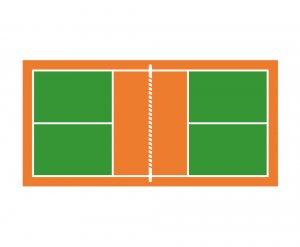
The standard pickleball court dimensions are the same size as the standard badminton court used for doubles. The pickleball court measurements are 20-feet wide and 44-feet long. This standard pickleball court size is used for both doubles and singles.
While the dimensions of a pickleball court are 20 x 44-feet, the play area is typically 30 to 34-feet wide and 60 to 64-feet long.
The pickleball court lines also need to be clearly marked. The lines are two-inches wide and should use a color that contrasts the color of the court.
How High Is a Pickleball Net?
The height of a pickleball net can vary, depending on whether you measure at the posts or in the center of the net.
The pickleball nets are set at a height of 36-inches on the side posts and need to maintain a height of 34-inches in the center. If the net cannot remain taught, a post is occasionally added in the center to keep the pickleball net height at 34-inches.
What Is Pickleball Court Made From?
Pickleball courts are made using the same process used to create a standard outdoor tennis court. The court is comprised of a concrete or asphalt slab covered with a layer of acrylic pickleball court surfacing.
The concrete slab must be completely level and should match the dimensions for the play area, which is about 30 by 60-feet for a typical backyard court.
A layer is added on top of the base concrete layer. It is an acrylic material that is spread over the top of the concrete to help fill in any holes or imperfections, creating a smooth surface.
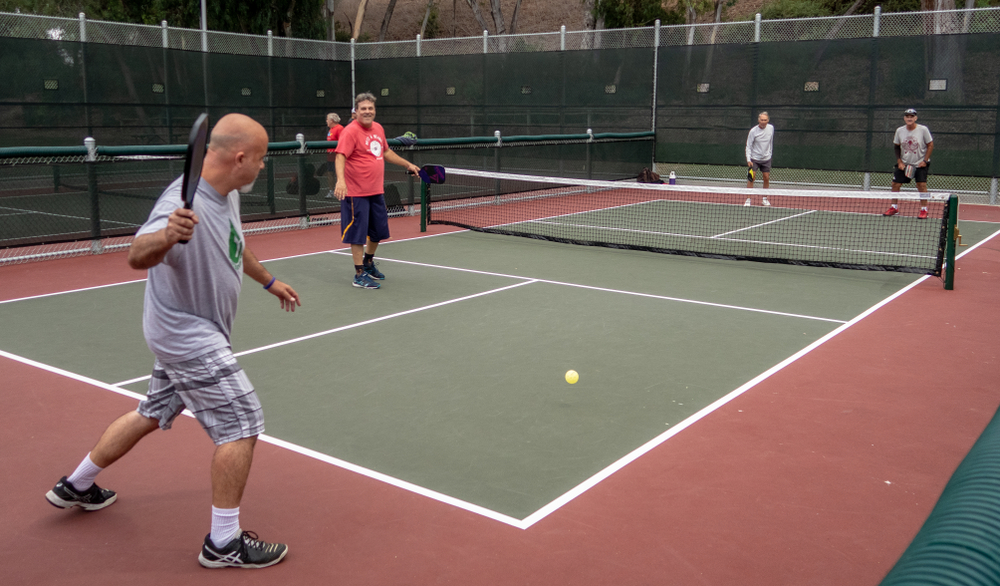
The top layer is a finish made from acrylic and available in a variety of colors. When the material dries, it provides a non-slip playing surface. The lines are then painted on the surface, following the standard pickleball court dimensions.
Some pickleball court suppliers and installers offer additional layers to add cushioning to the court. These cushioned layers are made from a rubber material that adds more shock absorption.
What Are the Pickleball Lines?
The pickleball court includes lines to separate the various parts of the court. These lines are required to be two inches wide. They also need to contrast with the color of the court. However, most lines are white, unless the court is a very light color.
When discussing the rules of pickleball, the lines are occasionally referenced. Understanding where these lines are placed may help you pick up the game:
- Baseline – the lines that run parallel to the net on each back end
- Centerline – the line that runs down the middle of the court between the baseline and no-volley zone
- Sidelines – the lines that run perpendicular on each side of the court
- No-volley line – marks the no-volley zone
The lines separate the court into several main areas, including the no-volley zone and the two service courts on each side.
The no-volley zone is a seven-foot strip behind the net on each side. Inside this zone, you cannot volley the ball with your paddle.
The service courts are behind the no-volley zone and are separated into the left and right service courts for each player.
What Are the Basic Rules of Pickleball?
How do you play pickleball? The standard pickleball court rules were created about 50 years ago. They’ve gone through a few changes over the years. However, they’re easy to understand, as the game was originally created for children.
When playing pickleball, you first need to decide between singles and doubles matches. In a single match, you face one other pickleball player. With a doubles match, two players compete against two players.
The server starts in his or her right-side service court. With each alternating serve, players switch to the other service court. For example, during your second serve, you will stand in the left-side service court.
The serve needs to clear the net and land in the service court. It must then bounce once and get returned by the other player. The server then lets the ball bounce once before starting normal play.
The server also needs to keep both feet behind the backline when serving. If the ball lands outside of the service court, a fault is called, and the service is awarded to the opposing side.
A fault is called when the ball touches any part of the non-volley zone during the serve. A fault also occurs when the balls are hit out of bounds, are volleyed from the non-volley zone, do not clear the net, or do not bounce on each side of the net.
When serving the ball, players must always use an underhand serve. However, you can still use a forehand or backhand swing.
Most players use a forehand swing. If you want to try this swing, stand with your dominant side back and your opposite foot forward.
For example, if you are right-handed, hold the ball in your left hand, and put your left foot forward. Point your left shoulder toward your target, and bring the paddle back in your right arm. Drop the ball with your left hand, and bring your paddle up and forward with the right hand.
If you struggle to master the forehand swing, you can attempt the backhand swing. This requires a more side-stride position, facing the opposite direction. Drop the ball, and swing your paddle toward the ball as it falls downward.
How Does Scoring Work in Pickleball?
Players only score points when serving. The serving player continues to serve until he or she commits a fault. The server scores a point when the returning player fails to return a fair ball.
The game is typically played to 11 points, and a player must win by 2 points. For example, if you and your opponent are tied with 10 points, you need to score 2 more points to win.
Play continues until one player has a lead of 2 points. However, some tournaments have higher point totals. Instead of 11 points, players may play to 15 or 21 points.
If you want to learn more about how to properly keep score? We have a whole post all about how pickleball scoring works.
What Is a Non-Volley Zone?
Pickleball courts feature an area called the no-volley zone (NVZ). The NVZ ends seven-feet behind the net, preventing players from power slamming the pickleball when close to the net.
As mentioned, the standard dimension of the pickleball court is 20 x 44-feet. This is a short playing area, especially compared to tennis. If player volleys the ball from close to the net, it becomes much harder for the other player to return the ball.
Allowing players to volley near the net would create an unfair advantage for power players. They could easily dominate smaller players.
With the non-volley zone, volleying is prohibited near the net, evening the playing field. The non-volley zone is a seven-foot stretch behind the net and in front of the service courts.
Learn exclusively about the non-valley zone from one of our favorite video channel.
What Is the Double Bounce Rule?
The double-bounce rule requires both players to let the ball bounce once before the ball can be played off the bounce or volleyed.
For example, the first player serves the ball over the net. The second player allows it to bounce once and serves it back. The first player allows the ball to bounce once. Normal play then begins. As each player allows the ball to bounce once, it is the double-bounce rule.
What Are Pickleball Paddles Made From?
The first pickleball paddles were made from wood, which can easily break or splitter. Wood was eventually replaced with graphite and composite as the preferred options.
However, graphite and composite are materials used for the surface of the paddle. These paddles also have core material.
The core material is typically either made from Nomex, polymer, or aluminum. The core material provides the bounce. With a quality core material, you get a bigger strike zone on the paddle and less impact on your wrist.
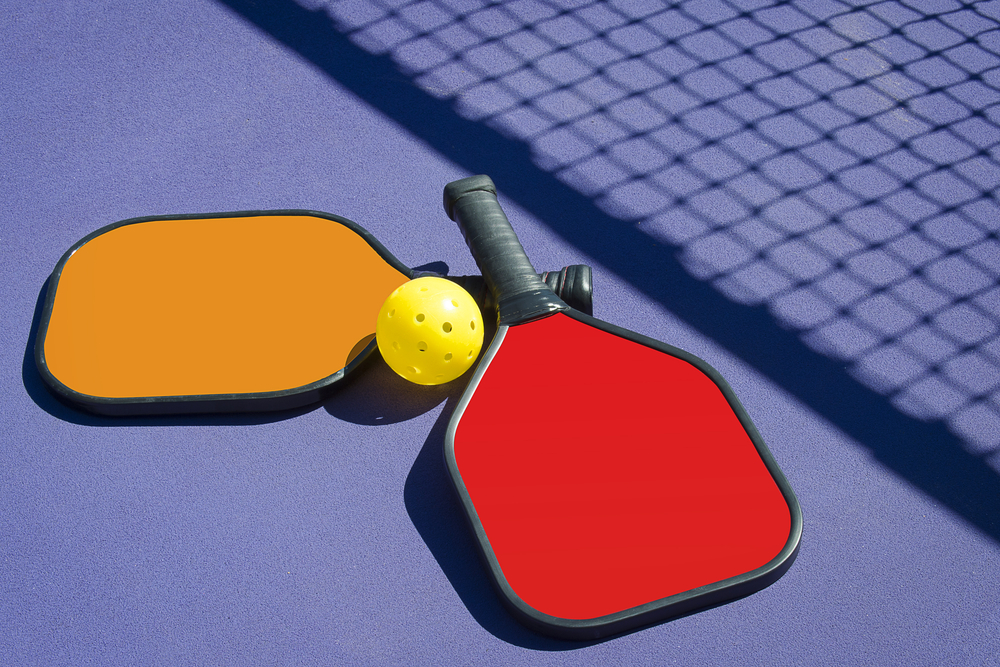
Nomex is the hardest core material and provides less power. Those who want more control over their serves may benefit from a Nomex core, which also makes it a great choice for beginners.
Polymer cores are softer and have large honeycomb cells. The material is quieter and offers more power compared to the Nomex cores, but it lacks some of the precision.
Aluminum cores provide greater control, less power, and less durability. However, aluminum core paddles also tend to be less expensive.
The core material is covered with a surface material called the facing. The most common choices for facing include fiberglass, graphite, and carbon fiber.
Fiberglass facings are also called composite facings. They are the most common and provide the most power. However, they are the least durable option.
The graphite facings are more durable compared to composite facings, but they lose a little bit of the power. They make up for the lack of power with more control.
The carbon fiber facings offer the most ball control and less power. They are also the most durable, and they provide many years of use with less risk of cracking or breaking.
What is the Difference Between Pickleball Balls and Wiffle Balls?
What is a pickleball? When pickleball was first invented, the inventors used a wiffle ball to play the game. As the game evolved, a new ball was created.
The wiffle ball typically features 8 oblong holes, while the pickleball ball has at least 26 holes. Official pickleball balls can have up to 40 holes. Balls intended for outdoor play tend to have more holes, while indoor balls often feature fewer holes.
The shapes of the holes are also different. Wiffle balls have oblong holes while pickleballs have round holes.
Both balls are about the same size. The standard pickleball size is 3-inches, and wiffle balls are typically 2.94-inches. However, pickleball balls are a little heavier. Wiffle balls often weigh 0.7 ounces, while pickleball balls weigh between 0.8 and 1.02-ounces.
Pickleball balls also have a series of restrictions and regulations for official tournament use. For example, the ball cannot be multi-colored. It needs to be made from a single color, and white is the most common choice.
The ball must also provide a specific amount of bounce when dropped from a height of 78-inches. When dropped from this height, the ball must reach a height between 30 and 34-inches.
It also needs to be dropped onto a granite surface measuring 12 x 12 x 4-inches in an environment that is between 75 and 80-degrees Fahrenheit.
How Is a Pickleball Paddle Different from a Ping-Pong Paddle?
The inventors of pickleball also borrowed from ping-pong. The original game was played with ping-pong paddles, which were eventually replaced with wooden paddles.
Ping pong paddles are much smaller compared to pickleball paddles. The average blade is 6.7-inches long and 5.9-inches wide.
Pickleball paddles are available in a variety of widths and lengths. The width and length cannot exceed a total of 24-inches, according to the official requirements for USAPA-approved paddles.
You can have a paddle that is rectangular, square, or rounded. They can also be wide or narrow. There are also no restrictions on the thickness of the paddle.
Pickleball vs Tennis – What’s the Difference?
There are many differences between tennis and pickleball, including the net height. When comparing the pickleball net height vs tennis net height, the tennis net is higher.
What is the height of a pickleball net? As mentioned, the standard height in the center of the net is 34-inches. Tennis nets are set at a height of 3.5-feet along the posts and 36-inches at the center.
The dimension of the pickleball court is also different. The standard pickle court dimensions are 20 x 44-feet, which is much smaller compared to the standard tennis court.
Tennis courts measure 78-feet long and 27-feet wide, for singles matches. Doubles matches are played on courts that are 36-feet wide.
The racquets are also longer. Most pickleball paddles are about 15 to 16-inches long, while tennis racquets often measure 27 to 29-inches.
The pickleball court dimensions are smaller, the paddles are smaller compared to the racquets, and the ball is smaller.
Pickleball vs Platform Tennis – What’s the Difference?
Besides standard tennis, platform tennis is another game that people may confuse with pickleball. Both games are played on small courts and use paddles. There are also major differences.
Platform tennis is played on a raised platform, instead of on the ground. The raised deck measures 30 by 60 feet and includes a court measuring 20 by 40 feet.
The platform is enclosed with a screen measuring 12-feet high, which keeps the ball from bouncing out of the play area.
The game is played with a rubber ball, and the paddle has holes through it. With the holes, players can generate faster swings with the paddle, which allows them to send the rubber ball flying at faster speeds.
Platform tennis also features the same basic scoring structure used for tennis. The first point is 15, followed by 30, 40, and “game.” You need to win six games to take a set and most matches are played with three sets.
While platform tennis and pickleball are completely different games, they have a couple of similarities. Both games are played on 20 by 44 foot courts.
They both use solid paddles while regular tennis uses a strung racquet. However, pickleball paddles do not have holes through them.
In the end, these are vastly different games. Platform tennis is not as popular. It is also a much more intense game, similar to racquetball or handball.
What Is USAPA?
The USA Pickleball Association (USAPA) was founded in 1984. It was created to help promote and grow the sport.
While it is a national organization, they also help promote the sport internationally. They are the major governing body for determining the official rules, rankings, and tournaments for pickleball.
The USAPA is not a business. They are a nonprofit organization and managed by a board of directors. They are dedicated to developing the sport and encouraging people of all ages to start playing.
The USAPA website includes a wealth of resources for finding pickleball tournaments and courts. You can also find the latest rankings, rules, and tips for playing pickleball.
How Can I Find Pickleball Courts Near Me?
People often want to know, “where can I play pickleball?” If you want to practice, you can use a tennis court or badminton court. However, if you want to play on a real pickleball court, you may need to search your local gyms, sports clubs, and sports complexes.
Where can I find pickleball near me? If you live in the United States, you can also visit the official websites of the USAPA to find local pickleball tournaments.
Are there outdoor pickleball courts near me? Besides finding local tournaments, the USAPA website may help you find local pickleball courts where you can play or practice. There are thousands of courts throughout the US.
In fact, the number of courts in the US has increased by 500% in just 7 years. In 2010, there were less than 1,000 courts. 7 years later, there are over 5,500 pickleball courts. The USAPA also estimates that there are close to 22,000 total courts in the world.
Some of the facilities that are most likely to offer pickleball courts include:
- Sports complexes
- Local gyms
- Sports clubs
- Schools and universities
- Private clubs and resorts
- Your own backyard
If you have a flat surface and enough space for the standard pickleball court dimensions, you can set up a court in your own backyard.
You can purchase a kit for setting up a court. These kits typically consist of two posts, a net, two to four paddles, and a few pickle balls. However, a bare concrete or asphalt surface does not provide the same bounce or spin, compared to a permanent pickleball court.
How Many People Play Pickleball?
Pickleball isn’t very old. It was created a little over 50 years ago. However, the pickleball game has attracted a lot of players.
Last year, according to pickleball growth statistics released by the Sports & Fitness Industry Association, over 2.8 million people in the US play pickleball. It’s also one of the fastest growing sports.
The number of pickleball players in the US may currently be above three million.
In the past few years, the sport has gained interest from TV stations and sponsors. There are now professional endorsements and large prizes for the major tournaments. More people are competing and watching these tournaments.
The annual US Open Championships attracted over 2,100 pickleball players in 2018. It was held over seven days in Naples, Florida. This event continues to grow by about 40% each year.
During the 2018 USA Pickleball Nationals, a total of 2,300 competitors faced off for a $100,000 grand prize.
The most recent nationals were held at the Indian Wells Tennis Garden, which is the second-largest tennis stadium. It was also broadcast on ESPN. Indian Wells will continue to host the event for the next five years.
As pickleball continues to gain more players, it has naturally attracted professional players from other sports, including tennis.
Several retired tennis pros now compete in the professional pickleball tournaments and tours. Some of these pros are even sponsored by major pickleball equipment manufacturers.
How Many Calories One Can Burn Playing Pickleball?
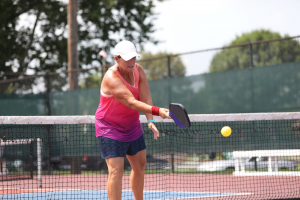
Pickleball is a lot like tennis or badminton, as you need to constantly move around, which can help you burn calories.
However, the number of calories burned playing pickleball depends on how long you play and the intensity of your play style.
If you play aggressively, you’re likely to end up with more calories burned playing pickleball, compared to playing a casual game. You can maximize your total calories burned playing pickleball by ensuring that you remain active.
You can burn about 250 calories per 30 minutes of play. If you play aggressively, you may increase this to about 350 calories.
Why is pickleball a great form of exercise? This sport requires a lot of stops and starts. When you constantly need to spring to action, pause, and then spring into action, you get a more effective workout.
Does Pickleball Have Any Special Terms or Phrases?
Many of the terms used in pickleball are carried over from the sports that it borrowed from. If you are familiar with tennis, you may know some of the following pickleball terms:
- Cross-court – the opposite corner of the court
- Dink shot – when a player purposely hits the ball into the no-volley zone
- Double bounce – when the ball bounces twice before getting returned
- Drop shot- when a groundstroke is too short
- Fault – when a player violates one of the rules
- Groundstroke – when a player hits the ball after one bounce
- Half volley – when the player hits the ball immediately after it bounces
- Hinder – when something impacts the gameplay
- Let – a serve that sends the ball to the service court
- Lob – when the ball returns in a high arc
- Passing shot – when the player serves the ball to prevent a ball return
- Rally – when a player continues to play after the serve, but before a fault
- Side out – when the server sends the ball into the service court.
- Technical foul – when a player violates a rule or acts in an aggressive manner
Understanding these terms may help you learn more about the game when reading tips online or searching for advice. People who regularly play the game often use pickleball lingo, just as in any other sport.
If you want to learn these terms quickly, look for televised or pre-recorded official tournaments. Players and refs often call out these terms throughout the gameplay.
What Should You Wear When Playing Pickleball?
There are no strict guidelines for pickleball attire. Most people wear clothing that is comfortable. The most common choices include standard tennis gear – shorts and a t-shirt.
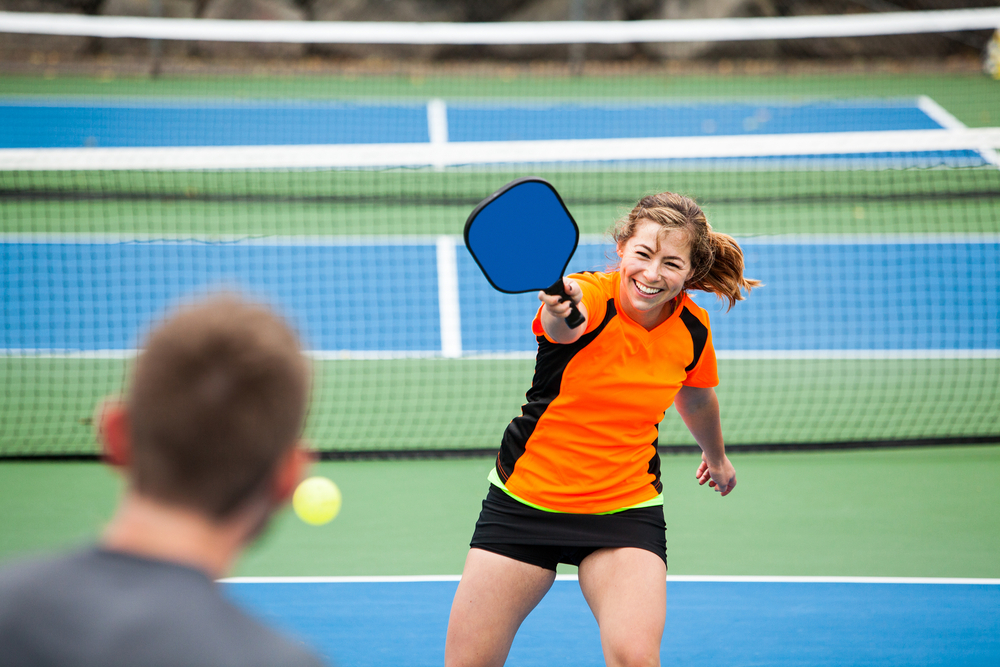
You should also wear shoes that are comfortable to move in. When playing pickleball, you will be moving on your heels and rotating your ankles. You may require tennis shoes or sneakers to provide optimal support and protection. If the sport becomes more popular, you may start seeing pickleball shoes.
What Else Should I Know About Pickleball?
That about covers everything that you may need to know about pickleball. You should now know the basic rules of the game, pickleball court dimensions, and where to find local pickleball courts near you.
If you want to start playing, you should consider buying a couple of paddles and a ball and then find a local court to start practicing. With a little practice, you may even become a professional pickleball player.wor
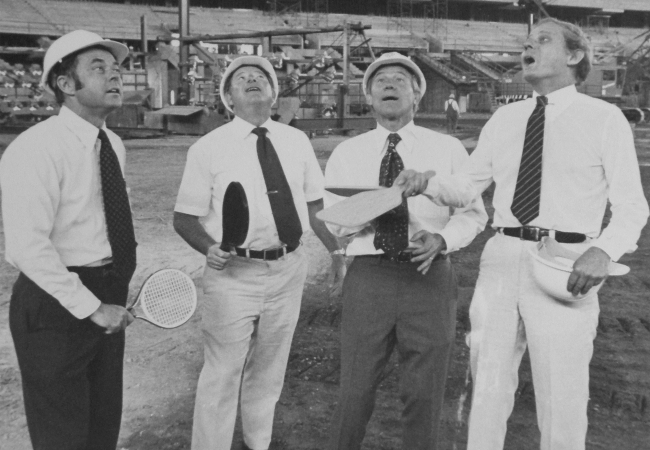
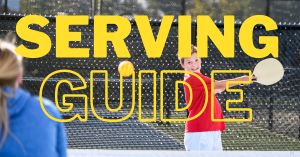
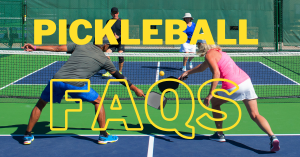
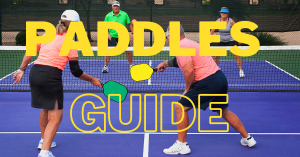

4 thoughts on “Pickleball FAQs : Everything You Need To Know About Pickleball”
Great, precise information. I do think etiquette should be emphasized, as in most sports,
it makes the game more enjoyable.
I agree with you, Betsy. Rules are in place for the exact reason so sports can be played in a disciplinary manner.
I would like to know if a ball clips the net and drops over and lands on the horizontal bar is that considered a let.?
If it’s on the serve, then it is a let and will be replayed.